#Pottery in India
Text
Creative Expression Awaits - Your Introduction to Pottery
A complete pottery experience typically involves several steps, including preparing the clay, shaping the pottery, decorating it, and firing it. Here's a more detailed explanation of each step:
Preparing the Clay: The first step in making pottery is to prepare the clay. This can involve soaking and wedging the clay to remove any air bubbles, which can cause the pottery to crack during the firing process.
Shaping the Pottery: Once the clay has been prepared, the next step is to shape it into the desired form. This can be done using a variety of techniques, including hand-building, where the clay is shaped by hand, or wheel-throwing, where the clay is shaped on a potter's wheel.
Decorating the Pottery: After the pottery has been shaped, it can be decorated using a variety of techniques, such as glazing, which involves applying a layer of liquid clay to the surface, or slip trailing, where a thin line of clay is applied to the surface using a tool.
Firing the Pottery: The final step in the pottery-making process is firing the pottery. This involves heating the clay in a kiln to a high temperature, which causes it to harden and become durable. Different clays and glazes will require different firing temperatures and firing schedules.
After the pottery has been fired and cooled, it is ready to be used or displayed. The complete pottery experience can be both challenging and rewarding, as it requires a combination of creativity, technical skill, and patience to produce a finished piece. You can visit dharamkot studio for details and learn ancient pottery skills.
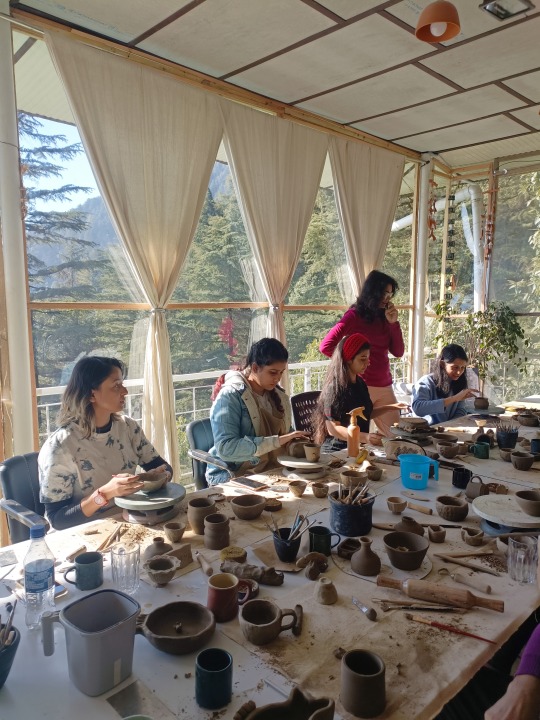
#Pottery in India#Indian pottery#Best pottery studio in India#Ceramic courses in India#Pottery workshop#dharamshala#Mcleodganj#Thing to do in dharamshala#artist#pottery#retreat#creative retreat
1 note
·
View note
Text

“Woman potter in the Khuri village, Thar Desert, Rajasthan, India.” 2000.
789 notes
·
View notes
Photo

Himanshu blue art pottery ❤️ Ceramic hanger Dm to order 9057218339 #bluepottery #jaipurpottery #hanger #bathroomdecor #ceramics #madeindia #art #crafts #handicraft #jaipur #pottery #india #handmade #india #makeindia #decoreation #blueartpottery https://www.instagram.com/p/CoEWWd7vE_l/?igshid=NGJjMDIxMWI=
#bluepottery#jaipurpottery#hanger#bathroomdecor#ceramics#madeindia#art#crafts#handicraft#jaipur#pottery#india#handmade#makeindia#decoreation#blueartpottery
2 notes
·
View notes
Text










“We live in the world when we love it.”
-Rabindranath Tagore
#pottery#architecture#ceramics#aesthetic#india market#travel#photography#home & lifestyle#cozy aesthetic#creative#art#santiniketan#Bolpur
4 notes
·
View notes
Text
youtube
Every week, Eco India brings you stories that inspire you to build a cleaner, greener and better tomorrow.
Cigarettes pose a big risk to human health. Their impact on the environment is less well-known. So consider this: Trillions of toxic cigarette butts are tossed out every year, and most don’t land in the trash. Initiatives here in India aim to tackle the problem at its source, and are converting these tiny stubs into sustainable, practical products.
****
Credits:
Supervising Producer: Nooshin Mowla
Script & Field Producer: Jessica Goel
Video Editor: Sujit Lad
Associate Producer: Ipsita Basu
Director of Photography: Richard Kujur
Camera Assistant: Abhishek Yadav
Executive Producer: Sannuta Raghu
#scroll.in#eco india#solarpunk#Cigarettes#cigarette butts#trash#recycling#pottery#Giriraj Prasad#planters#lanterns#ash tray#Oshil Bansal#pollution#Shankar Singh#Project Leher#Vrikshit Foundation#plastic#Thomas Novotny#Kajal Goyal#Buttrush Campaign#Hardik Aggarwal#Youtube#india
3 notes
·
View notes
Text
History of Jaipur Blue Pottery
Jaipur, the capital city of Rajasthan, is renowned for its vibrant art and craft traditions, from intricately carved marble to bold textiles. However, one of its most notable contributions to the world of handicrafts is its exquisite blue pottery. A delicate blend of Persian influence and Rajasthani artistry, Jaipur blue pottery has captured the attention of art lovers worldwide, standing as a…
#Block Printing India#Blue Pottery Manufacturers in Jaipur#Jaipur blue pottery manufacturers from India
0 notes
Text
Wheeler was holding a fragment of a Roman wine jar dug up at Arikamedu (Pondicherry), eighty miles down the coast. He took the overnight train and after a long, alcoholic breakfast at the town's French legation, went looking for Romans.
An inner room of the public library contained three or four museum cases. I strode hopefully forward, and, removing the dust with an excessively sweaty arm, peered into them. For the second time within the month, my eyes started in their sockets. Crowded together were fragments of a dozen more Roman amphorae [wine jars], part of a Roman lamp, a Roman intaglio [cameo brooch], a mass of Indian material – potsherds, beads, terracottas – and several fragments of a red-glazed ware no one trained in the school of classical archaeology could mistake.
"Why the West Rules – For Now: The patterns of history and what they reveal about the future" - Ian Morris
#book quotes#why the west rules – for now#ian morris#nonfiction#mortimer wheeler#archaeology#pottery#fragment#roman#india#wine jar#amphora#lamp#intaglio#cameo brooch#potsherd#bead#terracotta#arikamedu#pondicherry#overnight train
0 notes
Text
Handmade Clay Pottery Exporters in India | Top Pottery Suppliers in Madhya Pradesh, India || Seven Seas Trade
Seven Seas Trade exports 100% trustable exporter of Best Handmade Clay Pottery in India. Our company is the world's largest Handmade Clay Pottery exporters and suppliers across India.

#Handmade Clay Pottery Exporters in India#Top Pottery Suppliers in Madhya Pradesh#India#Seven Seas Trade
0 notes
Text
The Types of Ceramics for Making Attractive Pottery
Connect with Sowpeace if you like to buy terracotta products online for reasonable pricing on one-of-a-kind items that will transform your house.
Read More >>

#was terracotta expensive#in which state terracotta is famous#is terracotta the same as pottery#what is so special about terracotta#India
0 notes
Text
The Beauty of Terracotta Art
Clay tumblers, plates, fountains, masks, planters, pots, diyas and more adorn many homes in India
Lamps in greens, yellows and red mingled with browns are a common sight in most villages and now cities too in India. Moving away from the rustic unglazed finish, the artisans offer state-of-the-art objects such as beautifully painted African masks, fountains, diyas, table pieces, wall hangings,…

View On WordPress
#crafts of India#earthanware#earthen utensils#handicrafts#india crafts council#potter#pottery#Travel Feature
0 notes
Text
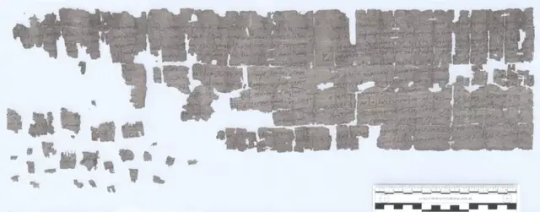
Archaeologists Find Roman Centurions' Letters in Ancient Animal Cemetery in Egypt
Discovered among the graves of hundreds of cats, dogs and monkeys, the correspondence was likely written by centurions in the first century.
An ancient pet cemetery in Egypt is becoming a gold mine for rare Roman history. Alongside its carefully constructed graves of more than 200 beloved cats, dogs and monkeys, archaeologists have now found letters handwritten 1,900 years ago by Roman centurions stationed nearby.
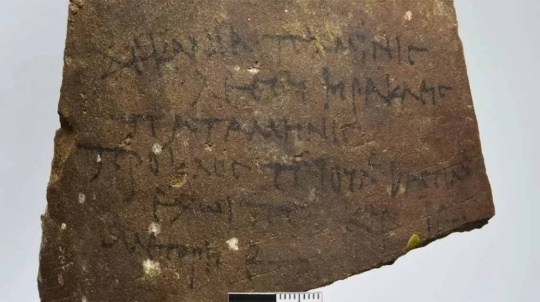
Though Rome controlled Egypt for centuries—from the year 30 to the mid-600s—few Roman sites still exist in the region, lead researcher Marta Osypińska, an archaeologist at Poland’s University of Wrocław’s Institute of Archaeology, tells Science in Poland’s Ewelina Krajczyńska. The burial ground, which dates back to the first and second centuries, is located in Berenike, a Red Sea port in southern Egypt built by Roman Emperor Tiberius.
Osypińska’s team first discovered the cemetery in 2011, and they’ve been slowly excavating it since then. Among the burials of cats, dogs and exotic monkeys, researchers have found ceramics, Roman coins and now, several letters written on papyrus by military officers who commanded units of Roman legions.
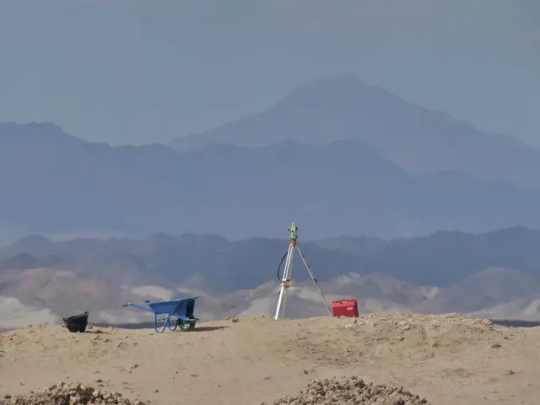
According to a statement by the University of Wrocław, these “priceless sources of knowledge about the ancient inhabitants of Berenike” are from the era of Emperor Nero, a cruel Roman ruler of the mid-first century. During his reign, Berenike was a hub of cross-continental trade, through which goods from India, Arabia and East Africa flowed, Osypińska says in the statement. The port was home to regional merchants, Roman higher-ups in charge of trading and—as historians have long suspected but never before proven—a unit of the Roman military.
The newly-found correspondence contains several names of presumed Roman centurions: Haosus, Lucinius and Petronius. In one letter, Petronius asks Lucinius, who is stationed in Berenike, about the prices of some exclusive goods, Osypińska tells Science in Poland. Petronius writes that he’s sending money via “dromedarius,” a unit of Roman soldiers traveling on camels, and tells Lucinius to provide the soldiers with veal and tentpoles.
Researchers believe ancient Romans likely kept the papyri in a nearby office which was later destroyed, accidentally distributing its contents over the pet cemetery, as McClatchy’s Aspen Pflughoeft writes. Excavators found the papyrus in rolled fragments, which they showed to Rodney Asta, an expert of ancient inscriptions, who pieced together a page approximately one and a half feet long and a foot wide, Osypińska tells Science in Poland. Among the animal graves, researchers have found countless ostracons—pieces of pottery etched with writing—but the papyri are the first paper texts to be found on-site.
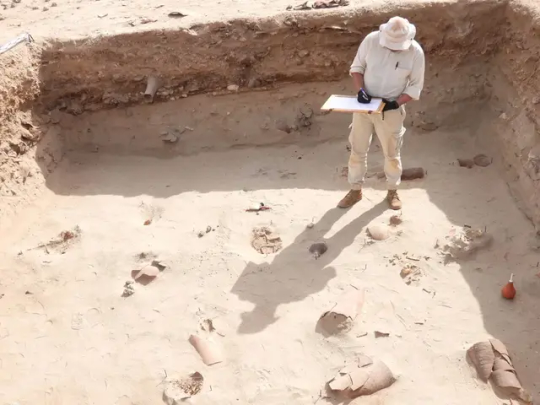


The letters are the latest evidence of advanced Roman trade to be found in the cemetery, per the statement: The skeletons of several buried monkeys, recently identified as macaques native to India, show that Romans imported non-utilitarian animals across oceans. These primates, along with long-haired cats and miniature dogs, were “elite pets,” and many were buried with toys, ceramics or other animal companions.
As Osypińska notes in the statement, it may seem difficult to reconcile the image of commanders of an ancient foreign legion with such animals, which were “treated as family members.”
“However, our findings unequivocally show that the military elite surrounded themselves with elite pets and led an exclusive lifestyle,” she adds.
By Sonja Anderson.

#Archaeologists Find Roman Centurions' Letters in Ancient Animal Cemetery in Egypt#Berenike#ancient pet cemetery in Egypt#Roman Emperor Tiberius#ancient artifacts#archeology#archeolgst#history#history news#ancient history#ancient culture#ancient civilizations#roman history#roman empire
74 notes
·
View notes
Text
Making Magic with Mud: A Journey through Beginners Pottery at Dharamkot Studio
Pottery is a form of art that has been around for thousands of years, and yet it remains a beloved and fascinating craft for millions of people all over the world. The Beginners Pottery Course offered at Dharamkot Studio is an excellent opportunity to learn the basics of this artistic medium and develop new skills that will last a lifetime. This course is designed for individuals who have little or no prior experience with pottery and want to explore this medium in a relaxed and supportive environment.
The Beginners Pottery Course offers a perfect blend of theory and practice. The students are introduced to the basic concepts of pottery, such as clay types, glazes, and firing techniques, before they start practicing on the wheel. The instructors are professionals with years of experience in the field, and they provide ample guidance and support to help students create beautiful pieces of art. The course is divided into several sessions, each focusing on a specific technique such as making a pinch pot, coiling technique, slab work, and throwing on the wheel. By the end of the course, students have the knowledge and skill to create a wide variety of finished products.
The course takes place at Dharamkot Studio, a spacious and well-lit facility surrounded by the stunning Himalayan mountains. The studio is a calm and serene space that fosters creativity and artistic expression. The instructors provide all the necessary materials and tools, so students can focus on their craft without worrying about the logistics. The studio also offers access to firing kilns and other specialized tools required to produce high-quality pottery.
One of the most significant benefits of the Beginners Pottery Course is the opportunity to work on the pottery wheel. While this technique can be challenging for beginners, it also provides an unparalleled sense of satisfaction and accomplishment. Students learn how to center the clay on the wheel and manipulate it to create different shapes, from bowls and cups to more complex items such as vases and teapots. With proper guidance and practice, students can develop their personal style and create their signature pieces.
The Beginners Pottery Course at Dharamkot Studio is not only an excellent opportunity to learn pottery but also a chance to connect with like-minded individuals who share an interest in art and creativity. The studio environment provides a supportive and collaborative atmosphere, and students can learn from each other's experiences. These interactions often lead to newfound friendships and a sense of community, which can be incredibly rewarding.
In conclusion, the Beginners Pottery Course offered at Dharamkot Studio is an excellent opportunity for individuals who want to explore the world of pottery. The course offers a perfect balance of theory and practical work, led by experienced instructors and set in a beautiful and peaceful environment. Students develop a wide range of skills and techniques, including the pottery wheel, and learn how to create unique pieces of art. Additionally, the course provides a chance to connect with other aspiring artists and create a sense of community. Whether one wants to develop a new hobby, explore art or simply try something new, the Beginners Pottery Course provides the perfect opportunity to do so.

0 notes
Text

“Potter removes fired clay pot.” Bishnoi village in Jodhpur, Rajasthan, India.
33 notes
·
View notes
Photo

Himanshu blue art pottery Beautiful ❤️🥰 hand made Blue art pottery decorative soap 🧼🧼 dispenser in different disigin and colour use for your Home and bathroom decoration ✨✨ [email protected] https://wa.me/c/919057218339 https://www.facebook.com/profile.php?id=100064706981288 Dm to order 9057218339 #blueart #blueartpottery #art #handmade #decoreation #artcrafts #jaipur #soap #dispanser #handicrafts #crafts #pottery #bathroom #decor #homedecor #india #giftideas #bottle #hastkala #exhibition #bathroomdecor #rajasthan #potterylove #artkala #artwork #art #artisan #handicraftsofindia https://www.instagram.com/p/CqPODTGvTkU/?igshid=NGJjMDIxMWI=
#blueart#blueartpottery#art#handmade#decoreation#artcrafts#jaipur#soap#dispanser#handicrafts#crafts#pottery#bathroom#decor#homedecor#india#giftideas#bottle#hastkala#exhibition#bathroomdecor#rajasthan#potterylove#artkala#artwork#artisan#handicraftsofindia
0 notes
Text
Folklore Fact - Gryphons/Griffins
Gryphons, griffins, griffons, however you prefer to spell it (I personally use gryphon) - let's talk their folklore and mythology!

(Attic pottery depicting a satyr and a griffin and an Arimaspus from around 375-350 BC, Eretria.)
You probably already know the common popular culture concept of a gryphon: a big, vicious beast that attacks people and probably eats them and/or carries people away to its nest to feed them to its babies. Not much about it has changed in legend, though in a lot of popular culture today, it has seemed to lose its divinity. Gryphons - griffins, whatever you prefer - have quite the robust history, like so many creatures of myth and folklore. Unlike some, however, they have changed very little over time.
Note that this article a general overview of concepts, not a detailed history.
Let's start with etymology, because I just love that stuff. The word "griffin" comes from the Greek word "gryps," which referred to a dragon or griffin and literally meant "curved [or] hook-nosed." Late Latin spelled it "gryphus," a misspelling of grypus, a Latinized version of the Greek (source: https://www.etymonline.com/, one of my favorite websites).
Griffins are said to have the head and wings of an eagle and body of a lion. They may or may not also have pointed ears, depending on the depiction (they more often did, overall, though the griffin of Crete is a notable exception). They were said to guard the gold in the mountains of the north, specifically the mountains of Scythia. The one-eyed Arimaspian people rode on horseback and attempted to steal the griffins' gold, causing griffins to nurture a deep hatred of and hostility toward horses.
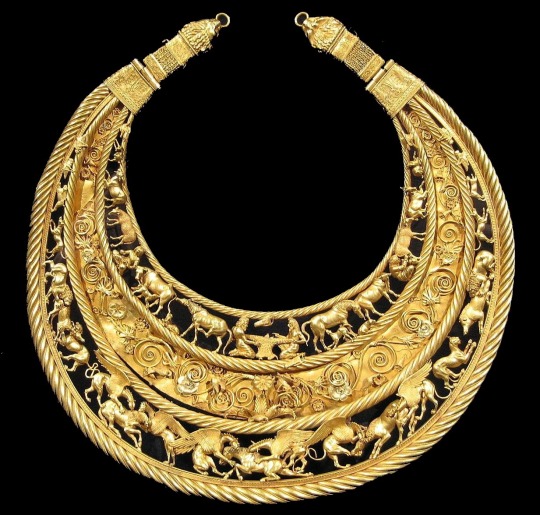
A Scythian pectoral, thought to have been made in Greece, depicting - among other things - griffins slaughtering horses. Griffins really, really hate horses.

The famous griffin in the palace of Knossos at Crete, from the Bronze Age (restored).
Griffins appear in truly ancient civilizations, not only Greece but also ancient Egypt and civilizations to the east, including ancient Sumeria. Griffins were later said to also dwell in India and guard gold in that region, and they continued to appear in art throughout ancient Persia, Rome, Byzantium, and into the Middle Ages throughout other regions such as France; they were depicted in ancient Greece with relative frequency and occasionally of considerable importance.
Griffins appeared in many ancient Greek writings, including Aristeas in the 7th century BC. Herodotus and Aeschylus preserved and continued these writings in the 5th century BC, including lines such as,
"But in the north of Europe there is by far the most gold. In this matter again I cannot say with assurance how the gold is produced, but it is said that one-eyed men called Arimaspoi (Arimaspians) steal it from Grypes (Griffins). The most outlying lands, though, as they enclose and wholly surround all the rest of the world, are likely to have those things which we think the finest and the rarest." Herodotus, Histories 3. 116. 1 (trans. Godley) (Greek historian C5th B.C.), source: https://www.theoi.com/Thaumasios/Grypes.html (a wonderful site)
Physical descriptions of the griffin were not commonplace until some later works, and even then, their appearance wasn't always agreed upon. Even the notion of griffins having wings was sometimes disputed. Some scholars even got pretty wild, claiming griffons had no wings at all but instead skin-flaps that they used to glide. They apparently hated awesome things, so it turns out there were always boring people who thought they knew everything, wanted to explain everything "logically," and generally assume they were the smartest ever while also ruining mystique. They would make great scientists today.
Griffins were, however, often said to be holy in nature. They were referred to as the "unbarking hounds of Zeus" by Aeschylus, who warned others never to approach them. Gryphons were also considered sacred to several gods, including prominently Apollo, who was said to depart Delphi each winter, flying on a griffon (griffin, gryphon, etc, I keep swapping this around, I know; my brain spells it differently because I've read way too many sources), and he also is occasionally depicted as hitching griffins to his chariot in addition to riding one. This was particularly prominent in the cults of Hyperborean Apollo, one of the many endless and fascinating cults of ancient Greece.

Medieval bestiary depiction of a griffin slaughtering a horse.
Even by the Middle Ages, gryphons still hated and slaughtered horses and guarded gold, elements that certainly persisted throughout their legends. They also killed men and carried them away to their nests, similar to the manner in which Aeschylus warned people to stay away from gryphons even back when. We can obviously assume griffons were never cuddly, so that isn't much of a change.
Griffins also did not entirely lose their divine relations even into the Middle Ages. Christianity often used positive portrayals of griffins to represent and uphold certain positive tenets of Christian faith; likewise, they became important symbols of medieval heraldry, used to represent a Christian symbol of divine power, as well as general courage, strength, and leadership, especially in a military sense. The depiction of the griffin as a powerful and majestic creature - killing horses and men or not - throughout its history is no doubt because they are a combination of two beasts often considered noble symbols of bravery, power, and divinity: the lion and the eagle, kings of land animals and birds, respectively.
That's a general overview! As you can see, griffins aren't always so bad, at least not compared to some of the other creatures out there from folklore and myth.
( If you like my blog, be sure to follow me here and sign up for my free newsletter for more folklore and fiction, including books!
Free Newsletter - maverickwerewolf.com (info + book shop) — Patreon — Wulfgard — Werewolf Fact Masterlist — Twitter — Vampire Fact Masterlist — Amazon Author page )
#folklore#mythology#gryphon#griffin#fantasy creature#gryphons#griffins#griffon#folklore fact#folklore thursday#greek myth#myth#persian myth#medival#medieval folklore#history
65 notes
·
View notes
Text
Am I missing something or what is the deal with a certain group of people literally denying the existence of Dacians?
I keep having articles pop up and the comments are usually from people who are obsessed with denying that Dacians existed. And I am not talking about the old uwu Romanians are from India so go back there filthy g**sies uwu or uwu you are Albanians who forged a new identity uwu. I am talking about uwu archaeologists found Dacian pottery from 200 BC? Did they also find alien bones inside that fake bullcrap? Here are burial grounds of our people from 1300. Where were you Aliencians? uwu
They sound as pathetic as those who come up with conspiracies that have no basis other than a discussion between a group of drunk men.
52 notes
·
View notes